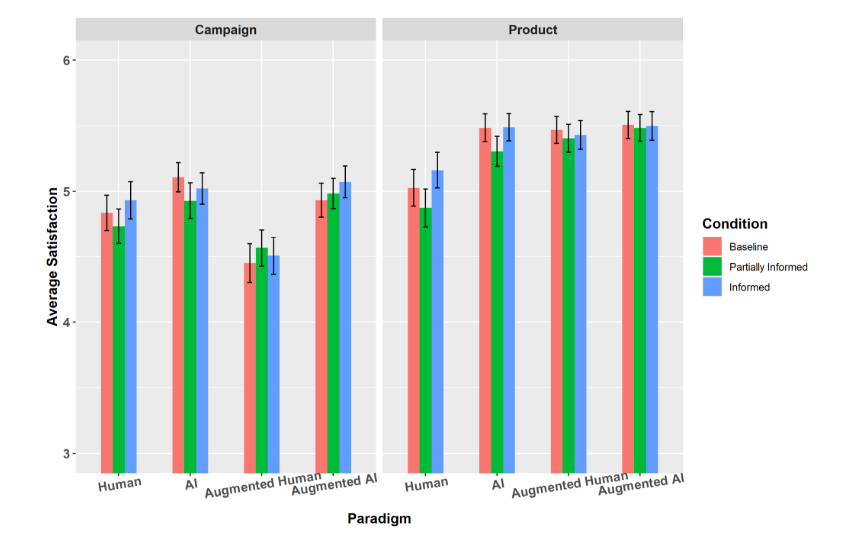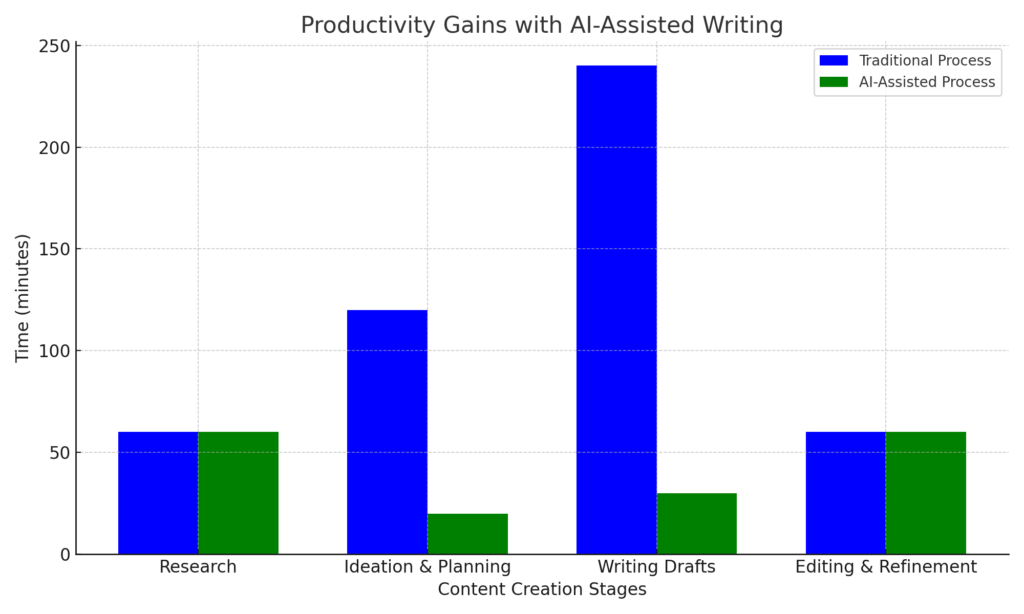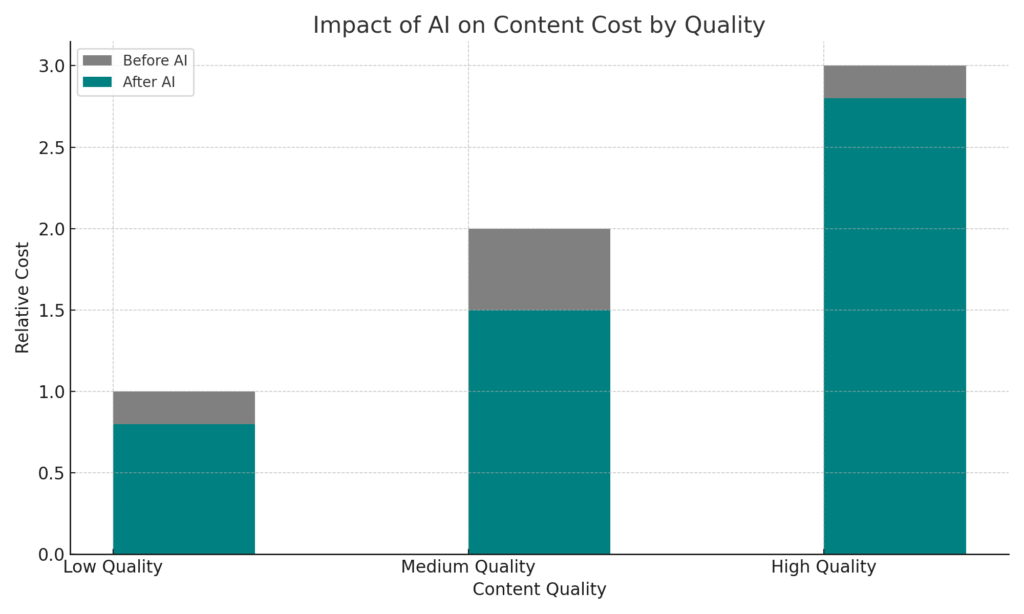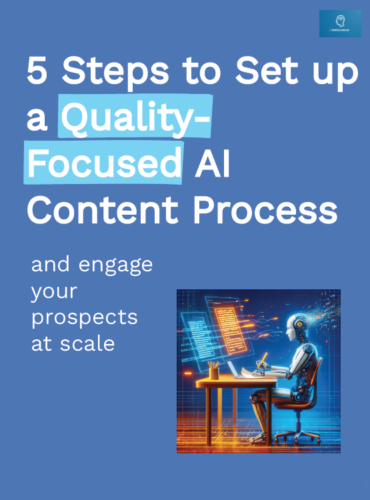Imagine being able to cut your content creation time in half while maintaining high quality.
This is the reality of becoming an AIO (Artificial Intelligence Optimization) writer.
LLMs like GPT-4 now enable you to streamline your writing process like never before -without you getting out of the process!
This article will tell you everything you need to know to become or hire an AIO writer.
What is an AIO Writer?

Being an AIO (Artificial Intelligence Optimization) writer involves combining LLM capabilities with your human writing expertise to create high-quality content.
You differentiate yourself from traditional writers who draft content from scratch, but also completely unsupervised AI content generation. Compared to full AI and manual writing, you use AI tools to generate initial drafts but then refine these drafts to enhance quality, accuracy, and engagement.
AIO writing is all about engaging fully in the AI generation process, using your prompting, metacognitive, and editing skills to improve AI output.
How Do AIO Writers, full AI writers, and human writers compare?

Since the release of GPT-4 in March 2024, AI writing capabilities have reached a critical quality threshold.
Previously, generative AI models were easy to spot due to obvious flaws and inconsistencies.
Now, it has become increasingly difficult to distinguish between AI and human writing. AI has learned to mimic human writing almost perfectly.
With AIO writing, this goes even further. You can leverage the efficiency of AI while masking the remaining peculiarities of AI-generated content.
Here’s how these three writing processes compare in terms of output quality :
Variability vs. Predictability
- Full AI Writer: AI-generated content often follows predictable patterns. Without specific instructions, AI tends to produce uniform content with similar sentence and paragraph structures. This predictability can make the content feel repetitive and less engaging.
- Human Writer: Human writers naturally introduce variability in their writing. They avoid repetition, use diverse sentence structures, and employ creative techniques to engage readers. This unpredictability is a hallmark of human writing, making it more compelling and relatable.
- AIO Writer: As an AIO writer, you can break the predictability by introducing variability into the AI-generated drafts. You can add unique insights, varied sentence structures, and pattern interrupts that keep readers engaged. This blend of AI efficiency and human creativity ensures more dynamic and engaging content.
Truthful vs. Accurate
- Full AI Writer: AI aims to predict the most likely next word based on its training data, prioritizing consistency over truthfulness. This can lead to “hallucinations,” where AI generates plausible but factually incorrect information. AI doesn’t inherently understand or prioritize factual accuracy.
- Human Writer: Human writers prioritize truthfulness and factual accuracy from the outset. They research and verify information before including it in their content.
- AIO Writer: As an AIO writer, you play a crucial role in ensuring factual accuracy. You review and fact-check AI-generated drafts, correcting any inaccuracies and ensuring the content is truthful. This combination of AI speed and human oversight produces reliable and accurate content.
Generic vs. Personal
- Full AI Writer: AI-generated content tends to be generic, expressing widely accepted ideas and avoiding specifics. This generic approach can make the content feel impersonal and less engaging for readers looking for unique perspectives.
- Human Writer: Human writers naturally incorporate personal experiences and unique perspectives into their writing. This personal touch makes their content more engaging and relatable. They can draw on their own expertise and experiences to provide depth and authenticity.
- AIO Writer: As an AIO writer, you add a personal touch to AI-generated drafts. You can include personal stories, unique insights, and subject expertise, making the content more relatable and engaging. This personalization enhances the connection with your audience.
The Studies around Quality Perception
The study “Human Favoritism, Not AI Aversion” has evaluated the results of three ways of writing ad content and assessed how much readers appreciate AI output.
Here are its conclusions :
Content generated solely by AI (ChatGPT-4) is perceived as higher quality than human-made content. Surprisingly, knowing the content is AI-generated does not significantly reduce its perceived quality. There is a lack of AI aversion and a neutral stance toward AI involvement in content creation.
The study also assess AIO writing perception in two forms: augmented AI (AI makes the final decision on the content output, with initial input from human experts) and Augmented Human (a human makes the final decision on the content output after receiving a draft from AI).
Both AIO models are perceived as producing higher-quality content overall compared to AI-only and human-only content.
How Much More Productive and Cost-Saving is AIO Writing?

Using ChatGPT-4 for your content writing can significantly boost your productivity and save you money.
Here’s a breakdown of the workflow for writing a 2000-word blog article and the potential time savings:
Research Work: 2 Hours Reduced to 2 Hours
ChatGPT-4 provides an initial overview of your subject, but it can’t replace in-depth research. The tool offers superficial and generic knowledge, so you’ll still need to gather new insights from external resources like expert interviews, company documentation, academic research, or personal experience.
Thus, you won’t save much time during the research phase, but this step ensures your content is accurate and insightful.
Building the Outline: 1 Hour Reduced to 30 Minutes
You can use ChatGPT-4 to create a basic outline for your content. However, don’t rely solely on AI for this step. The initial output might be too generic. Start by asking ChatGPT-4 for a preliminary outline, then refine it using the insights you gathered during your research.
This approach combines AI efficiency with the depth of human expertise, cutting your outlining time by half.
Writing: 4 Hours Reduced to 30 Minutes
This is where ChatGPT-4 shines. Generating content that takes hours for a human writer can be done in seconds with AI. Once you have your refined outline, you can prompt ChatGPT-4 to expand each section into detailed paragraphs.
The speed and efficiency of generative AI dramatically reduce your writing time from four hours to just 30 minutes. This alone represents a massive productivity gain.
Proofreading and Editing: 1 Hour Reduced to 1 Hour
While ChatGPT-4 can generate coherent text, its output may feel redundant or unnatural to human readers. The AI often structures paragraphs similarly, making the content predictable.
Therefore, you’ll need to spend time editing to ensure the text feels genuine and engaging.
ChatGPT-4 can assist with basic proofreading, but you should do the final edits manually to maintain a natural flow and tone.
Overall Time Savings
By incorporating ChatGPT-4, you can cut your total writing process time from eight hours to four hours. This means you achieve a 50% productivity gain, allowing you to produce more content in less time without compromising quality.
Cost Savings
A 2000-word article written by a human typically costs around $300. With AIO writing, you can get the same length of content for approximately $140. This significant cost reduction makes AIO writing an attractive option for your business. You save more than 50% on content creation costs while maintaining high-quality output.
Is AIO Profitable For a Writer?

As you can see, AI tools like ChatGPT-4 let you generate high-quality content faster. It allows you to take on more projects and meet tight deadlines without sacrificing quality. This increased efficiency doesn’t mean you should lower your rates unreasonably.
Clients will always need more content, and the demand for quality content remains high. By being more productive, you can offer more value to your clients at competitive rates. You can thus keep your income stable while expanding your workload.
The only condition for a profitable AIO career ? Leverage AI to produce content that truly stands out. Let AI handle the repetitive and time-consuming aspects of writing, freeing you to focus on refining and personalizing the content. By offering superior content, you can justify premium pricing.
The other advantage of AI is that it helps you overcome writer’s block and the blank page syndrome. With AI-generated drafts, you have a solid starting point, making it easier to get into the writing flow. This stimulation leads to more creative and engaging content, as you’re not bogged down by the initial struggle of starting from scratch.
The Writing Prompting Process of an AIO Writer

Providing the right prompts in the correct order ensures consistent, high-quality text that matches your desired style and tone. This process also lets you add your human knowledge and expertise, what I call the “hybrid approach.”
Based on my extensive experience, here’s a step-by-step process you can adapt for any content writing job:
1. Set the Writing Role and Context
Start by introducing ChatGPT to its writing job. Clearly define the role and provide all necessary details. Inform ChatGPT about its writing function, primary mission, and the audience’s expectations. Provide guidelines related to your brand’s tone and style.
For example:
You are an experienced content writer for your website. You’re writing for an audience of *your audience* who want to *their pain point*. With your content, you’re selling them *your product/service*.
Reply “Ok” if that’s clear to you.
2. Provide a Well-Chosen Sample
ChatGPT needs examples to understand what you want. Provide a text sample that best reflects your writing tone, style, and structure. Use a prompt like:
“Here’s a writing sample to help you determine what kind of writing style and tone we expect. Only reply ‘ok’ if the extract is clear for you. Here’s the extract: [Insert sample text here].”
3. Ask for an Outline
Guide ChatGPT in creating a detailed outline using the “chain of thoughts” prompting technique. This step helps you review ideas and add your insights before generating the full content. For example:
“Draft an outline for an article about creating content with ChatGPT by researching relevant ideas online.”
Then, refine the outline with your own input:
“Add the following ideas to the outline: [Insert unique insights].”
Gather insights from expert interviews, studies, professional resources, and your own experience.
4. Generate Content Section by Section
You’re better off asking ChatGPT to generate content section by section to review the quality throughout. Use prompts like:
“While strictly following the style, tone, and writing guidelines I gave you, write section 1 in 300 words.”
Enhance the output with feedback:
“Rewrite section 8 in 280 words, addressing the readers directly with ‘you’ and ‘your,’ and avoid repetitive structures.”
Don’t forget to ask for specific introductions and conclusions:
“Write a concise introduction for this article with a relevant hook to grab content managers’ attention.”
“Write a short conclusion for this article, including a call-to-action to subscribe to my newsletter about hybrid AI content processes.”
5. Proofread and Edit
Review the output from ChatGPT for consistency and make final edits.
Add variety to the writing style by including bullet points and varying paragraph lengths.
Check for misunderstandings and inaccuracies, ensuring the content aligns with your outlined ideas.
There you have it, everything to get you started as an AIO writer, or to hire one!





